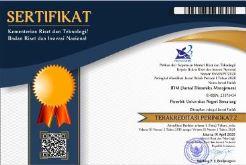Predicting the Relationship of Antecedent Variables of Intention to Use: Empirical Analysis on E-Money Application
Abstract
This study aims to predict the relationship of perceived usefulness, perceived ease of use, relative superiority, nature of transactions, and substitution to adoptions that affect intention to use of smart phone-based electronic money. The variables in this study are relative advantages, transaction nature, perceived usefulness, and perceived ease of use, substitution and adoption of electronic money. Data collection techniques in this study were conducted using a questionnaire with judgmental sampling method. The size of the respondents is 142 respondents. The data obtained is analyzed using Structural Equation Modeling (SEM). The results show that the six hypotheses are supported. The intention to use electronic money is also influenced by the adoption of electronic money. The adoption of electronic money is a significant predictor of intention to use electronic money. This study also provides limitations and suggestions for further research.
Keywords
Full Text:
PDFReferences
Agamitte, M. F. (2017). Analisis Penerimaan terhadap Teknologi Informasi pada Organisasi Sektor Publik (Studi Kasus pada Aplikasi LPSE Provinsi NTT). Thesis. Yogyakarta: Universitas Atma Jaya Yogyakarta.
Alqasa, K. M., Md Isa, F., Othman, S. N., & Zolait, A. H. S. (2014). The Impact of Students’ Attitude and Subjective Norm on the Behavioural Intention to Use Services of Banking System. International Journal of Business Information Systems, 15(1), 105-122.
Ayudya, A. C., & Wibowo, A. (2018). The Intention to Use E-Money Using Theory of Planned Behavior and Locus of Control. Jurnal Keuangan dan Perbankan, 22(2), 335-349.
Bank Indonesia. (2009). Peraturan Bank Indonesia No.11/12/PBI/2009. Uang Elektronik (Electronic Money).
Bank Indonesia. (2017). Statistik Sistem Pembayaran. Available at https://www.bi.go.id/id/Statistik/Sistem-Pembayaran/Uang-Elektronik/Contents/Transaksi.aspx. 8 April 2019.
Bank Indonesia. (2019). Informasi Perizinan Penyelenggara Dan Pendukung Jasa Sistem Pembayaran. Available at Https://Www.bi.go.id/Id/Sistem-Pembayaran/Informasi-Perizinan/Uang-Elektronik/Penyelenggara-Berizin/Pages/Default.aspx. 10 April 2019.
Bell, E., & Bryman, A. (2007). The Ethics of Management Research: an Exploratory Content Analysis. British Journal of Management, 18(1), 63-77.
Boehmke, F. J. (2009). Approaches to Modeling the Adoption and Diffusion of Policies with Multiple Components. State Politics & Policy Quarterly, 9(2), 229-252.
Chavali, K., & Kumar, A. (2018). Adoption of Mobile Banking and Perceived Risk in GCC. Banks and Bank Systems, 13(1), 72-79.
Cheung, C. M., Lee, M. K., & Rabjhon, N. (2008). The Impact of E-WoM-the Adoption of Online Opinions in Online Customer Communities. Internet Research, 18(3), 229-247.
Chianasta, F. P., & Wijaya, S. (2014). The Impact of Marketing Promotion through Social Media on People’s Buying Decision of Lenovo in Internet Era: a Survey of Social Media Users in Indonesia. International Journal of Scientific and Research Publications, 4(1), 1-6.
Davis, F. D. (1989). Perceived Usefulness, Perceived Ease of Use, and User Acceptance of Information Technology. MIS Quarterly, 319-340.
Erkan, I. (2016). The Influence of Electronic Word of Mouth in Social Media on Consumers’ Purchase Intentions. Doctoral Dissertation. London: Brunel University.
Erkan, I., & Evans, C. (2016). The Influence of Ewom in Social Media on Consumers’ Purchase Intentions: an Extended Approach to Information Adoption. Computers in Human Behavior, 61, 47-55.
Fadli, M., & Fachruddin, R. (2016). Pengaruh Persepsi Nasabah atas Risiko, Kepercayaan Manfaat, dan Kemudahan Peggunaan terhadap Penggunaan Internet Banking. Jurnal Ilmiah Mahasiswa Akuntansi, 1(2), 1-14.
Fornell, C., & Larcker, D. F. (1981). Evaluating Structural Equation Models with Unobservable Variables and Measurement Error. Journal of Marketing Research, 18(1), 39-50.
Fujiki, H., & Tanaka, M. (2009). Demand for Currency, New Technology and the Adoption of Electronic Money: Evidence Using Individual Household Data. Institute for Monetary and Economic Studies, 9, 1-39.
Gangwar, H. (2016). Understanding Cloud Computing Adoption: a Model Comparison Approach. Human Systems Management, 35(2), 93-114.
Ghozali, I., & Latan, H. (2015). Konsep, Teknik, Aplikasi Menggunakan Smart PLS 3.0 untuk Penelitian Empiris. Semarang: Badan Penerbit Universitas Diponegoro.
Girsang, M. A., & Hatammimi, J. (2014). Pengaruh Innovative Characteristics dan Barriers terhadap Adopsi Tik Berbasis Internet (Studi Umkm Batik pada Kampung Batik Kauman dan Pesindon Kota Pekalongan). Eproceedings of Management, 1(3), 1-7.
Hair Jr, J. F., Black, W. C., Babin, B. J., & Anderson, R. E. (2014). Multivariate Data Analysis 7Th Edition. NJ: Pearson Custom Library.
Hair Jr., J. F., Wolfinbarger, M., Money, A. H., Samouel, P., & Page, M. J. (2015). The Essentials of Business Research Methods. In the Essentials of Business Research Methods. New York : Routledge
Hair, J. F., Ringle, C. M., & Sarstedt, M. (2011). PLS-SEM: Indeed a Silver Bullet. Journal of Marketing Theory and Practice, 19(2), 139-152.
Hair, J. F. J., Hult, G. T. M., Ringle, C., & Sarstedt, M. (2016). A Primer on Partial Least Squares Structural Equation Modeling (PLS-SEM) 2nd Ed. Los Angeles: Sage Publications.
Hair Jr, J. F., Babin, B. J., & Krey, N. (2017). Covariance-Based Structural Equation Modeling in the Journal of Advertising: Review and Recommendations. Journal of Advertising, 46(1), 163-177.
Hair, J. F., Black, W. C., Babin, B. J., & Anderson, R. E. (2010). Multivariate Data Analysis. New York: Pearson.
Hair, J. F., Ringle, C. M., & Sarstedt, M. (2013). Partial Least Squares Structural Equation Modeling: Rigorous Applications, Better Results and Higher Acceptance. Long Range Planning, 46(1-2), 1-12.
Harridgeâ€March, S., Zhao, A. L., Hanmerâ€Lloyd, S., Ward, P., & Goode, M. M. (2008). Perceived Risk And Chinese Consumers’ Internet Banking Services Adoption. International Journal of Bank Marketing, 26(7), 505-525.
Heikkila, J. (2000). Geometric Camera Calibration Using Circular Control Points. IEEE Transactions on Pattern Analysis and Machine Intelligence, 22(10), 1066-1077.
Hoyle, R. H. (2011). Structural Equation Modeling for Social and Personality Psychology. London: Sage Publications.
Ilin, V., Ivetić, J., & Simić, D. (2017). Understanding the Determinants of E-Business Adoption in ERP-Enabled Firms and Non-ERP-Enabled Firms: a Case Study of the Western Balkan Peninsula. Technological Forecasting and Social Change, 125, 206-223.
Johnson, A. J. (2017). Reliability, Cronbach’s Alpha. Thousand Oaks: Sage Publications.
Johnson, B., & Christensen, L. (2014). Educational Research: Quantitative, Qualitative and Mixed Approaches. Thousand Oaks: Sage Publication.
Johnson, R. D., & Marakas, G. M. (2000). The Role of Behavioral Modeling in Computer Skills Acquisition: toward Refinement of the Model. Information Systems Research, 11(4), 402-417.
Khiaonarong, T. (2014). Oversight Issues in Mobile Payments. International Monetary Fund, 14-123.
Kim, S., & Garrison, G. (2009). Investigating Mobile Wireless Technology Adoption: an Extension of the Technology Acceptance Model. Information Systems Frontiers, 11(3), 323-333.
Kosse, A., & Vermeulen, R. (2014). Migrants’ Choice of Remittance Channel: do General Payment Habits Play a Role?. World Development, 62, 213-227.
Kotler, P., & Susanto, A. B. (2010). Dasar-Dasar Pemasaran. Jakarta: Salemba Empat.
Lee, M. C. (2009). Factors Influencing the Adoption of Internet Banking: an Integration of TAM and TPB with Perceived Risk and Perceived Benefit. Electronic Commerce Research and Applications, 8(3), 130-141.
Lee, Y. K., Park, J. H., Chung, N., & Blakeney, A. (2012). A Unified Perspective on the Factors Influencing Usage Intention toward Mobile Financial Services. Journal of Business Research, 65(11), 1590-1599.
Mahatanankoon, P., & Vila-Ruiz, J. (2007). Why Won't Consumers Adopt M-Commerce? an Exploratory Study. Journal of Internet Commerce, 6(4), 113-128.
Mantel, B. (2000). Why Do Consumers Pay Bills Electronically: an Emperical Analysis. Economic Perspective, 25(4), 32-48 .
Mas, I., & Almazán, M. (2014). Product Innovations on Mobile Money. European Journal of Business and Management, 6(19), 1-20.
Mashau, N. L. (2016). Issues Affecting the Adoption and Usage of Mobile Instant Messaging in Semi-Rural Public Schools of South Africa for Learning. Open Access Library Journal, 3(11), 1-13.
Miliani, L., Purwanegara, M. S., & Indriani, M. T. D. (2013). Adoption Behavior of E-Money Usage. Information Management & Business Review, 5(7), 369-378.
Moghavvemi, S., Hakimian, F., Feissal, T., & Faziharudean, T. M. (2012). Competitive Advantages through it Innovation Adoption by SMEs. SocialinÄ—s Technologijos/ Social Technologies, 2(1), 24-39.
Morrison, R., Matuszek, T., & Self, D. (2010). Preparing a Replication or Update Study in the Business Disciplines. European Journal of Scientific Research, 47(2), 278-287.
Musa, A., & Dabo, A. A. A. (2016). A Review of Rfid in Supply Chain Management: 2000-2015. Global Journal of Flexible Systems Management, 17(2), 189-228.
Muslichah, I. (2015). Analisis Anteseden pada Sikap dan Niat Menggunakan Blackberry dengan Dasar Model Penerimaan Teknologi. Jurnal Siasat Bisnis, 19(2), 170-183.
Mwiya, B., Chikumbi, F., Shikaputo, C., Kabala, E., Kaulung’ombe, B. & Siachinji, B. (2017) Examining Factors Influencing E-Banking Adoption: Evidence from Bank Customers in Zambia. American Journal of Industrial and Business Management, 7(6), 741-759
Nassuora, A. B. (2013). Understanding Factors Affecting the Adoption of M-Commerce by Consumers. Journal of Applied Sciences, 13(6), 913-918.
Niranjan, I., Saravanan, A. S., Patwa, N., & Reddy, S. K. (2016). Consumer Perceptions in Adopting E-Money in Developed Markets. International Journal of Academic Research, 4(4), 246-270.
Noviarni, E. (2017). Analisis Adopsi Layanan Internet Banking oleh Nasabah Perbankan di Pekanbaru (Technology Acceptance Model) Eni Noviarni. Jurnal Al-Iqtishad, 10(1), 26-39.
Ozuru, H. N., & Opara, B. C. (2014). Influence of Relative Advantage on Adoption of Electronic Banking Services in Nigeria. Technoscience Review, 5(1 & 2), 1-9.
Pane, E. S. (2014). Tingkat Adopsi Media Sosial sebagai Sarana Pemasaran Produk Industri Kecil dan Menengah Level Adoption of Social Media as an Marketing Tools of Small Medium Enterprises Products (Case Study on the Participants of Ikm Alumni in Surabaya. Jurnal Penelitian dan Pengembangan Komunikasi Dan Informatika, 5(1), 122-188.
Poon, W. C. (2008). Users’ Adoption of E-Banking Services: the Malaysian Perspective. Journal of Business and Industrial Marketing, 23(1), 59-69.
Pope, M., Pantages, R., Enachescu, N., Dinshaw, R., Joshlin, C., Stone, R., Seal, K. (2011). Mobile Payments: the Reality on the Ground in Selected Asian Countries and the United States. International Journal of Mobile Marketing, 6(2), 88-104.
Pradipta, V., & Agus, A. A. (2013). Analisis pengaruh Innovation Attributes dan Knowledge-Based Trust terhadap Behavioral Intention untuk Menggunakan Mobile Banking (Studi Kasus: Bank Mandiri di Jabodetabek). Unpublished Thesis. Depok: Universitas Indonesia.
Pratiwi, E. D. (2016). Faktor yang Mempengaruhi Niat Menggunakan Instagram dengan the Theory of Reasoned Action Menggunakan Amos 21. Jurnal Teknik Komputer, 2(1), 68-77.
Qiu, L., & Benbasat, I. (2010). A Study of Demographic Embodiments of Product Recommendation Agents in Electronic Commerce. International Journal of Human-Computer Studies, 68(10), 669-688.
Rahim, R. A., Sulaiman, Z., Chin, T. A., Zaidin, N., & Zakuan, N. (2015). E-WoM Review Adoption and Green Purchase Intention: the Application of Source Credibility Theory (SCT). Advanced Science Letters, 21(6), 2150-2154.
Ramli, N. A., Abdullah, C. S., & Nawi, M. N. M. (2017). Empirical Study of the Perceived Ease of Use and Relative Advantage on Load-Bearing Masonry (LBM) Technology Adoption. Proceedings. Presented at the AIP Conference, United States. 030006.
Rogers, E. (2003). Diffusion of Innovation, 5Th Ed. Visual Cognition. NY: Free Press.
Rowland, K. (2013). The Coming New Way to Pay.abn Bank Marketing.
Roy, S., & Sinha, I. (2017). Factors Affecting Customers’ Adoption of Electronic Payment: an Empirical Analysis. Journal of Business and Management, 19(12), 76-90.
Salimon, M. G., Yusoff, R. Z. Bin, & Mohd Mokhtar, S. S. (2017). The Mediating Role of Hedonic Motivation on the Relationship between Adoption of E-Banking and Its Determinants. International Journal of Bank Marketing, 35(4), 558-582.
Santomero, A. M., & Seater, J. J. (1996). Alternative Monies and the Demand for Media of Exchange. Journal of Money, Credit and Banking, 28(4), 942-960.
Schiffman, L. G., & Wisenblit, J. L. (2015). Consumer Behavior. US: Pearson.
Schumacker, R. E., & Lomax, R. G. (2015). A Beginner’s Guide to Structural Equation Modeling 4Th Edition. NY: Routledge.
Sekaran, U., & Bougie, R. (2016). Research Methods for Business: a Skill Building Approach. John Wiley & Sons. NY: Wiley.
Sensuse, D. I., & Widiatmika, I. M. A. A. (2012). Pengembangan Model Penerimaan Teknologi Internet oleh Pelajar dengan Menggunakan Konsep Technology Acceptance Model (TAM). Jurnal Sistem Informasi, 4(2), 81-92.
Shaughnessy, J. J., Zechmeister, E. B., & Zechmeister, J. S. (2012). Research Methods in Psychology. New York: Mc-Graw Hill.
Sugandini, D. (2009). Karakteristik Inovasi, Pengetahuan, Komunikasi Pemasaran, Persepsi Risiko dan Stockout dalam Keputusan Penundaan Adopsi Inovasi. Dissertation. Yogyakarta: Universitas Gadjah Mada.
Tazkiyyaturrohmah, R. (2018). Eksistensi Uang Elektronik sebagai Alat Transaksi Keuangan Modern. Muslim Heritage, 3(1), 23-44.
Thambiah, S., Eze, U. C., Tan, K. S., Nathan, R. J., & Lai, K. P. (2010). Conceptual Framework for the Adoption of Islamic Retail Banking Services in Malaysia. Journal of Electronic Banking Systems, 10(1), 1-10.
Utami, S. S. (2012). Pengaruh Teknologi Informasi dalam Perkembangan Bisnis. Jurnal Akuntansi dan Sistem Teknologi Informasi, 8(1).
Wei, O. J., & Ismail, H. B. (2009). Adoption of Technology among Businesses: the Strategic Adoption. Journal of Innovation and Business Best Practices, 1(1), 1-8.
Wei, T. T., Marthandan, G., Chong, A. Y. L., Ooi, K. B., & Arumugam, S. (2009). What Drives Malaysian M-Commerce Adoption? an Empirical Analysis. Industrial Management and Data Systems, 109(3), 370-388.
Wolf, E. J., Harrington, K. M., Clark, S. L., & Miller, M. W. (2013). Sample Size Requirements for Structural Equation Models: an Evaluation of Power, Bias, and Solution Propriety. Educational and Psychological Measurement, 73(6), 913-934.
Zikmund, W. G., Babin, B. J., Carr, J. C., & Griffin, M. (2010). Business Research Methods, Eight Edition. Canada: Cengage Learning.
View Counter: Abstract - 1265 and PDF - 693
Refbacks
- There are currently no refbacks.






